“I am not a number—I am a free man!”—The Prisoner
I’ve been trying to remember just exactly when and how I was introduced to the 1960s British TV series The Prisoner. I know it was in the first year of its original airing on CBS as a summer replacement show, so it must have been 1968. According the Internet Movie Database that would mark it as June 1, meaning I was 13 at the time and that seems about right. I also know that it stemmed from my father’s fondness for the Danger Man/Secret Agent TV series that had starred Patrick McGoohan. And I clearly remember that my father’s interest in the new series quickly palled because it was just too strange for him. For me, it was just stange enough.
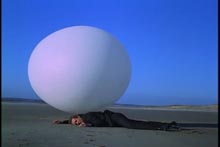
No, I’m not claiming that I really understood what this allegorical science-fiction series was about at the age of 13. That would be more than a little ridiculous. All I knew was that it was really cool, that it took place in this really neat place and boasted a super cool hero. Well, also it had a great opening credit sequence with a terrific theme. When you’re 13, that’s more than enough—while the business of your parents not “getting it” at all is the icing on the cake.
It wasn’t until the series came around again that it started making sense—or at least becoming obvious that it was something more than just way cool.. It helped that I had a—well, rather peculiar circle of friends. (Yes, I’m sure that surprises readers.) In between that first broadcast and the next, we’d expanded our horizons a good bit—mostly through having coming across 1920s and 30s playwrights (I have no idea how or why).
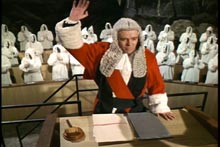
Now, reading the plays of folks like Philip Barry, Ben Hecht and Charles MacArthur, George S. Kaufman and Moss Hart, Marc Connelly, Irwin Shaw and a few older scribes like Ferenc Molnar has nothing to do with The Prisoner. However, works like Kaufman and Hart’s Merrily We Roll Along had given us a taste of non-traditional structure, while Molnar’s Liliom and Shaw’s Bury the Dead had introduced us to the idea of allegory. It worked as a fair basis for seeing The Prisoner in a somewhat different light—at least sort of. Let’s face it, the bottom line was that it was cool, while the show’s still-controversial final episode, “Fall-Out,” was a badge-of-honor challenge to follow, let alone interpret. We rose to the occasion as only pretentious youngsters can—settling on that venerable concept, “I don’t understand it, so it must be art.”
I freely mock our youthful enthusiasm, but I do know that we did recognize that there was more here than met the eye. And that, I think, is the secret of the series. It doesn’t give up its mysteries easily. As a result, it keeps drawing you back. Hell, here I am 40 years later and I’m still working it out. Think not? Well, when I rewatched episode one, “Arrival,” for review this past weekend, I discovered—or rethought—a couple things that had just been background for me previously.
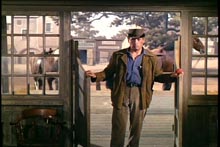
Let’s back up a little and look at the overall premise of the series. In an extended opening credit sequence (a shortened version is on most of the other episodes), “Arrival” starts with a grim faced man (Patrick McGoohan) driving a Lotus Seven across an empty, flat landscape at a high rate of speed. We then see him driving through London traffic and into a subterranean parking garage. He then walks through a door marked “Way Out.” (Though the phrase “way out” has a separate meaning, it should be noted that the British do use it for “exit,” making this as much an anti-authoritarian gesture—going in through the out door—as a comment on the oddness of what lies before us.) He flings open the double doors of an office, standing in the doorway in a kind of crucifixion pose (a not uncommon image throughout the series), then storms in making an obviously angry—but unheard—speech. He puts an envelope marked, “Private—Personal—By Hand,” on the desk of the man he’s speaking to. Slamming his fist on the desk for emphasis—an action the reverberations of which upset a cup of tea—he leaves and returns home.
Returning to his house—significantly No. 1 Buckingham Place—he’s followed by a car, a hearse. Inside, he packs to go—somewhere. But while he’s doing this, a gent looking much like an undertaker or pallbearer comes to the door and forces a white gas through the keyhole. The man passes out and later awakens in what seems to be the same room, but when he looks out the window, finds it’s a recreation of his London home, and that he’s in some fanciful other location, which he—and we—will come to know as the Village.
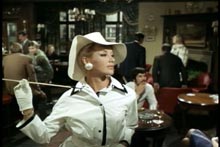
This first episode spends a good deal of its running time setting up his situation there—something that is best summed up by the opening exchange that starts most (not all) of the subsequent episodes between the Prisoner and the apparent man in charge, Number Two (played by a variety of actors over the course of the 17 shows).
Prisoner: “Where am I?”
No. Two: “In the Village.”
Prisoner: “What do you want?”
No. Two: “Information.”
Prisoner: “Whose side are you on?”
No. Two: “That would be telling. We want information, information, information!”
Prisoner: “You won’t get it.”
No. Two: “By hook or by crook, we will.”
Prisoner: “Who are you?”
No. Two: “The New Number Two.”
Prisoner: “Who is Number One?”
No. Two: “You are Number Six.”
Prisoner: “I am not a number—I am a free man!”

The Prisoner’s pronouncement of his status as a free man results in laughter from the various Number Twos—and with good reason, since he’s very much a prisoner in this strange world where the powers that be—whoever they are—are determined to find out the answer to the key question: “Why did you resign?”
Looked at in the time period in which it was made, all of this has a broad application to the mood of the era. People at the time were starting to question the status quo in increasingly militant ways—“questioning the decisions of those we’ve elected to govern us” is how it’s phrased in the show’s final episode. And those representing the status quo naturally wanted to silence this questioning—as well as understand the why behind it. The question of “why did you resign” then is as pertinent to why did you resign from mainstream, accepted thought, as it is to why the Prisoner resigned from whatever (apparent) governmental position he held.
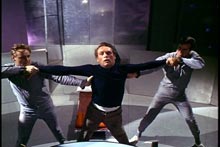
Something of the key to the enigma of the series overall—even its “answer”—is included in that one exchange. There are other—very subtle—clues in that first episode. Mottos on the walls of the Village offices also have multiple meanings. “A still tongue makes a happy life,” for example, is only true so far as keeping whatever secrets you’ve learned to yourself. Put into practice against the Village by the Prisoner, it hardly makes for a happy life. The phrase, “Questions are a burden to others, answers a prison for oneself,” also carries a double meaning—one that the second part of which is only clear after we learn what that answer is.
At the same time, it’s worth noting that the series—which was the brainchild of Patrick McGoohan and George Markstein—held a simpler and more personal meaning. It does come at the end of McGoohan’s stint of playing secret agent John Drake in the long-running Danger Man/Secret Agent TV series. As a result, the business of resigning from a secret governmental position is in part a reflection of McGoohan being fed up with the role. Indeed, it’s hard—actually impossible—not to connect his transformation into Number Six with the lyric in the previous show’s theme song, “Secret Agent Man,” “They’ve given you a number and taken away your name.” That also makes it hard not to assume that Number Six and John Drake are the same person. McGoohan has steadfastly denied this, but it should be remembered that producer Ralph Smart owned the rights to Danger Man. A direct connection would have made Smart due royalties.
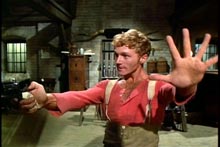
There’s more to The Prisoner than that, though. Otherwise its appeal would have long ago ceased. So much of it has a feeling that I can only describe as tongue-tied eloquence. By this I mean it’s the work of people in reaction to the world around them—people feeling compelled to make a statement without being completely able to verbalize what that statement is. There’s a need—almost to the point of desperation—to say it at any cost. That gives the series a certain air of incoherence perhaps, but it also gives it a sense of immediacy—indeed, McGoohan found himself writing the complex final episode in a matter of a few days prior to shooting it—that time hasn’t dimmed. Ironically—and despite McGoohan’s original intention that there only be seven episodes, not 17—it’s ultimately as if the series was working out the statement it—or McGoohan—wanted to make as it went along.
I’m not about to try to go into the show’s 17 episodes in the time and space I have here. And I’m certainly not going to get into the various arguments about which order the shows should be run in. (Yes, Prisoner fanatics are every bit as obsessive as the adherents of Star Trek or Star Wars.) Put it this way—you pretty much have to start with “Arrival,” and you have to end with “Once Upon a Time” and “Fall Out” (the former leads into the latter). Also, episodes like “Living in Harmony” and “The Girl Who Was Death”—the former done as a western, the latter as an almost completely unrelated spy spoof—would be close to nonsensical seen without a few other episodes to build the viewer up for their departures from the format. Otherwise, I’ve never been sold on the idea that it matters all that much whether “Arrival” should be followed by “Free for All” or “Dance of the Dead” or (as it was originally run in the U.S.) “Chimes of Big Ben.” It probably depends entirely on your penchant for minutiae.
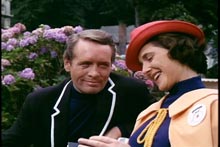
Now, I’ll admit to a degree of nerd-dom as concerns the series, which is to say that, yes, I’ve gone to the extent of actually going to Portmeirion—the Italianette village near Penrhyndeudraeth (no, I can’t pronounce it either) in Wales that served as both inspiration and exteriors for the Village. I’ll also warn anyone who entertains the idea of going there that, fascinating and even wonderful as it is, prepare for a shock or two. The biggest of these will occur when you enter Number Six’s cottage in the Village. Just realize that when you enter it in the series, the interior is completely a soundstage at MGM studios at Borehamwood in England. When you enter it in Portmeirion…well, there’s no relation (and it would require the size-expanding qualities of Dr. Who’s TARDIS to recreate the set in it).
Whether you go to any such extreme as actually paying a call on the Village, I do highly recommend The Prisoner to anyone who values intellectually challenging viewing material. Indeed, I recommend it to anyone who cares about cinema—nevermind that it’s TV. There’s some astonishing filmmaking going on in these shows, especially those directed by McGoohan himself (under his own name with “Free for All,” “Once Upon a Time” and “Fall Out” and as Joseph Serf on “Many Happy Returns” and “A Change of Mind”). Though it would be incomprehensible out of context—there are those who find it incomprehensible in context—“Fall Out” is in itself a spectacular piece of filmmaking in its own right. (It’s also a brilliant piece of writing, though that’s difficult to discuss unless you’ve seen the series and are ready to debate its various meanings.)
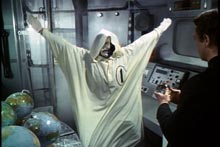
At the same time, don’t sell the other entries short. Even if McGoohan felt that the show should have consisted of only seven episodes, there’s much to admire in the other entries. The departure shows—like “Living in Harmony” and “The Girl Who Was Death”—have a lot going for them, if only in the sheer chutzpah of them being so far afield from the series, while finally being revealed as anything but. “The Girl Who Was Death” is especially fine in that it doubles as a very clever satire on the then-very-popular spy genre. Such contemporary TV fare as Mission: Impossible gets a ribbing in the episode, as do some of the cheesier elements of even the James Bond films in the show’s deliberate use of painfully obvious rear-screen work. (And you thought that was an original idea of the Austin Powers movies, huh?)
The fact is that none of the episodes are without merit. A few—“The General” and “Checkmate,” come to mind—may be considered as lesser shows, but the quality level even there is remarkably high. In other words all 17 shows are worth your while. There are no clunkers here, because the overall premise is so strong. The themes of the often surreal stories—loss of identity, forced conformity, dream manipulation, mind control—were relevant then and are still relevant today.
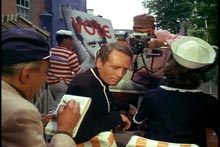
As to what it all means—well, you’ll have to watch it and decide for yourself. The show guards its secrets carefully and, as I said, doesn’t give up its mysteries easily. I’m not even sure that there is a definitive answer as to the ultimate meaning of The Prisoner—at least not on all levels. There may only be a definitive personal interpretation of it all. And that may be for the best. It’s possible that there are a number of perfectly valid readings of the series, which is perhaps its great strength. After all, is anything that can be interpreted one way and only one way worth bothering to interpret at all?




Nothing beat seeing the Prisoner as a kid, like you did. All the mystique was thrilling. Who cared if you couldn’t figure it out? That big giant globe as a prison guard or whatever it was – the creepiest! Time to give this series another look.
Time to give this series another look.
It is indeed, Mrs. Russell! And nice to see you on board. I have the impression that T’other Ken (the one you’re married to) admired the show, too, from some things he said to me years ago (starting with a comment about what a letdown Portmeirion is when you really see it).
Ken,
Great piece. The series is well worth rediscovering.
BTW I’m a bigger Prisoner Geek than you: My street address is Number Six.
Be Seeing You.
BTW I’m a bigger Prisoner Geek than you: My street address is Number Six.
Now, the question is whether or not you went out of your way to find a location with that address? If you did, I gladly yield the lamp of geekdom to you.
I actually did know someone in LA who sold one house to buy a house of almost identical value and amenities solely because the new house would give him an actual “Hollywood, California” address.
I didn’t, but it really did kinda seal the deal for me.
I’ve seen Portmeirion too, but only from aboard a Welsh train, looking across Cardigan Bay.
I didn’t, but it really did kinda seal the deal for me.
Well, that’s perfectly reasonable.
I’ve seen Portmeirion too, but only from aboard a Welsh train, looking across Cardigan Bay.
I’m not at all sorry I went, but I’m not sure I’d do it again — maybe if it hadn’t been late September and more things had been in bloom, I’d have felt a little more like I was “in the Village.”